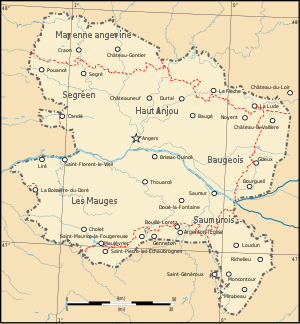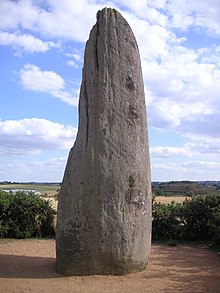Mauges

Mauges is the name of a western French landscape within the former county of Anjou or today's Maine-et-Loire department . The area of the Mauges is defined less historically than natural geography.
location
In terms of natural geography, the granite and slate- rich plateau of the Mauges, sloping gently to the south, forms the extreme southeast of the Armorican massif, which makes up a large part of Brittany further west . The area is bounded in the north by the Loire , in the east by the Layon river , in the west by the Sèvre Nantaise and the Moine ; in the south and south-west the boundaries to the Vendée are blurred - this is why one sometimes speaks of the Vendée angevin . The most important cities are Cholet and Beaupréau ; the most important river in the interior of the Mauges is the Èvre , which flows from south to north and flows into the Loire at Saint-Florent-le-Vieil . The highest point is the hill of Trottières (216 meters above sea level).
economy
Early medieval names for the landscape all contain the Latin word metallica , which suggests ore mining; but so far no mines etc. have been found. Apart from a few small and medium-sized towns, the Mauges area is largely characterized by agriculture. In the east of the Mauges - unlike in the other parts - even viticulture can be practiced.
history
In the Cholet area, prehistoric stone tools have been found that are between 300,000 and 400,000 years old; Traces of the Neanderthal man between 10,000 and 100,000 years old have also been discovered. There are also some prehistoric monuments ( menhirs , dolmens ) in the Mauges; however, Celtic tribes and Romans left no archaeological traces.
In Carolingian times the area belonged to the Kingdom of Aquitaine ; it was not until Fulco Nerra conquered it for the county of Anjou in the 1st half of the 11th century . The existence of the two cities Cholet and Beaupréau is attested for the 2nd half of the 11th century.
Overall, the area of the Mauges was always in the shadow of the large and important counties ( comtés ) or duchies ( duchés ) of the surrounding area. Only in the short period of the Vendée uprising , i. H. In the years 1793 to 1796, the western French landscape moved into the focus of French, sometimes even European, interest for a few years. Above all, many dissatisfied peasants joined the Catholic-royalist movement, which was able to defeat the initially weakly occupied republican garrisons in the cities (Cholet, Angers ) relatively easily. Ultimately, however, the movement ended in a wave of executions and displacement that bordered on genocide, instigated by the revolutionary forces.
Attractions


The Mauges do not belong to the classical cultural landscapes of France - despite the strong religious anchoring of the population in Catholicism, Romanesque and Gothic church buildings are almost completely missing .
- prehistory
- Roc-en-Pail in Chalonnes-sur-Loire
- Menhir de la Garde, today in Cholet
- Menhir La Haute-Borne in Saint-Germain-sur-Moine
- Menhir La Grande Pierre Levée in Saint-Macaire-en-Mauges
- Churches and monasteries
- Abbaye du Montglonne (13th century) in Saint-Florent-le-Vieil
- Chapelle de la Bernardière (15th and 18th centuries) in Saint-Macaire-en-Mauges
- Chapelle Notre-Dame-de-Toutes-Aides (17th and 18th centuries) in Maulévrier
- Église Notre-Dame (19th century) in Beaupréau
- Église Saint-Pavin (19th century) in Le Pin-en-Mauges
- Église Sacré-Cœur (20th century) in Cholet
- Castles and Palaces
- Château of Chemillé (12th / 13th century)
- Château des Hayes (15th / 16th century) in Andrezé
- Château de la Guérinière (17th / 18th century) in Bégrolles-en-Mauges
- Civil structures
- Tour du Grenier à sel (16th century) in Cholet
- 15th and 16th century houses in Maulévrier
- Mill of l'Epinay in La Chapelle-Saint-Florent
- Moulin (13th / 14th century) in Champtoceaux
- Bridge over the Èvre (15th century) in Montrevault
- Museums
- Musée d'art et d'histoire in Cholet
- Musée du textile in Cholet
- Cathelineau Museum in Le Pin-en-Mauges
- Musée d'histoire locale et des guerres de Vendée in Saint-Florent-le-Vieil
- Musée des métiers de Saint-Laurent-de-la-Plaine
literature
- Yves Boiteau: L'Evre, miroir des Mauges. CPIE Loire et Mauges, 2010
- Teddy Véron: L'intégration des Mauges à l'Anjou au XIe siècle. Pulim, 2007
